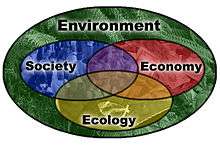Computational sustainability
Computational sustainability is a broad field that attempts to optimize societal, economic, and environmental resources using methods from mathematics and computer science fields.[1] Sustainability in this context is the ability to produce enough energy for the world to support its biological systems. Using the power of computers to process large quantities of information, decision making algorithms allocate resources based on real-time information.[2]
| A subtopic of sustainability |
| Computational sustainability |
|---|
 |
| Also relevant to: |
| Global warming Renewable energy Sustainable development |
| Aspects of Computational Sustainability: |
| Smart grid Sustainable agriculture Intelligent transportation systems Sustainability |
Applications are widespread. Smart grids implement renewable resources and storage capabilities to control the production and expenditure of energy.[3] Intelligent transportation system analyze road conditions and relay information to drivers so they can make smarter decisions based on real time traffic information.[4]
Transportation
Intelligent Transportation Systems (ITS) seek to improve safety and travel times while minimizing greenhouse gas emissions for all travelers, though focusing mainly on drivers. ITS has two systems: one for data collection/relaying, and another for data processing. Data collection can be achieved with video cameras over busy areas, sensors that detect various pieces from location of certain vehicles to infrastructure that's breaking down, and even drivers who notice an accident and use a mobile app, like Waze, to report its whereabouts.[4][5]
Advanced Public Transportation Systems (APTS) aim to make public transportation more efficient and convenient for its riders. Electronic payment methods allow users to add money to their smart cards at stations and online. APTS relay information to transit facilities about current vehicle locations to give riders expected wait times on screens at stations and directly to customers' smart phones. Advanced Traffic Management Systems (ATMS) collect information using cameras and other sensors that gather information regarding how congested roads are. Ramp meters regulate the number of cars entering highways to limit backups. Traffic signals use algorithms to optimize travel times depending on the number of cars on the road. Electronic highway signs relay information regarding travel times, detours, and accidents that may affect drivers ability to reach their destination.[5]
With the rise of consumer connectivity, less infrastructure is needed for these ITS to make informed decisions.[6] Google Maps uses smartphone crowdsourcing to get information about real-time traffic conditions allowing motorists to make decisions based on toll roads, travel times, and overall distance traveled.[7] Cars communicate with their manufacturers to remotely install software updates when new features are added or bugs are being patched.[8] Tesla Motors even uses these updates to increase their cars efficiency and performance.[9] These connections give ITS a means to accurately collect information and even relay that information to drivers with no other infrastructure needed.
Future ITS systems will aid in car communication with not just the infrastructure, but with other cars as well.[4][5]
Utilities
The electrical grid was designed to send consumers electricity from electricity generators for a monthly fee based on usage. Homeowners are installing solar panels and large batteries to store the power created by these panels. A smart grid is being created to accommodate the new energy sources. Rather than just electricity being sent to a household to be consumed by the various appliances in the home, electricity can flow in either direction. Additional sensors along the grid will improve information collection and decreased downtime during power outages. These sensors can also relay information directly to consumers about how much energy they're using and what the costs will be.[10]
See also
References
- "www.computational-sustainability.org". www.computational-sustainability.org. Retrieved 2016-03-25.
- Frenkel, Karen A. (1 September 2009). "Computer Science meets environmental science". Communications of the ACM. 52 (9): 23. doi:10.1145/1562164.1562174. Retrieved 13 March 2019.
- "CompSustNet: Home". www.compsust.net. Retrieved 2016-03-25.
- Guerrero-ibanez, J. A.; Zeadally, S.; Contreras-Castillo, J. (2015-12-01). "Integration challenges of intelligent transportation systems with connected vehicle, cloud computing, and internet of things technologies". IEEE Wireless Communications. 22 (6): 122–128. doi:10.1109/MWC.2015.7368833. ISSN 1536-1284.
- Timotheou, Stelios; Panayiotou, Christos G.; Polycarpou, Marios M. (2015-01-01). Kyriakides, Elias; Polycarpou, Marios (eds.). Transportation Systems: Monitoring, Control, and Security. Studies in Computational Intelligence. Springer Berlin Heidelberg. pp. 125–166. doi:10.1007/978-3-662-44160-2_5. ISBN 9783662441596.
- "The Shift to Constant Connectivity". Think with Google. Retrieved 2016-03-31.
- "How Google Tracks Traffic". www.ncta.com. Retrieved 2016-03-31.
- "Your next car will update itself while you sleep, and maybe watch you too". Digital Trends. 2016-01-27. Retrieved 2016-03-31.
- Sparkes, Matthew (2015-01-30). "Tesla software update: did your car just get faster?". Telegraph.co.uk. Retrieved 2016-03-31.
- "Solar Power on the Rise". Union of Concerned Scientists. Retrieved 2016-04-07.
External links
| Wikibooks has a book on the topic of: Artificial Intelligence for Computational Sustainability: A Lab Companion |